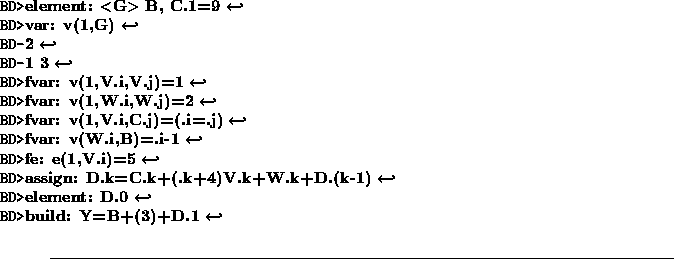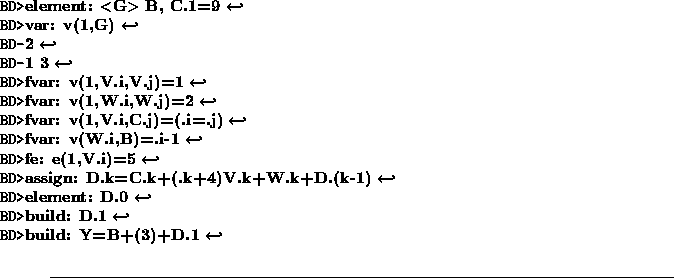




Next: Attaching data to the
Up: Constructing new elements from
Previous: Constructing new elements from
A simple example involving assignments elements and components is as
follows. Suppose that  are element names, that
are element names, that  is an
assignment including functional indices, and that
is an
assignment including functional indices, and that  and
and  are the names of components summarising many like quantities. A number
of declarations are shown in Figure 6.1. These are as
follows:
are the names of components summarising many like quantities. A number
of declarations are shown in Figure 6.1. These are as
follows:
- The declaration of two elements,
 (the latter given an
expectation of nine; the former having
(the latter given an
expectation of nine; the former having  by default)
gathered into the base G, followed by their variance-covariance
matrix.
by default)
gathered into the base G, followed by their variance-covariance
matrix. - Functional specifications for variances over the components
 and
and  ; covariances between
; covariances between  and
and  , and covariances
between
, and covariances
between  and
and  . All other variance-covariance
specifications (for example, between V and W) are to be zero by
default.
. All other variance-covariance
specifications (for example, between V and W) are to be zero by
default. - A functional specification of an expectation for the component
 .
. - The definition of the recursive assignment
 , together with
the definition of the element
, together with
the definition of the element  as a termination criterion for
the recursive assignment.
as a termination criterion for
the recursive assignment. - The BUILD: command. When this command is activated, it
will be discovered that
 is not an element, and so a check is
made to see whether it is an assignment. It is, so D.1 is replaced by
the linear combination it represents, and the linear combination to be
built is thus
is not an element, and so a check is
made to see whether it is an assignment. It is, so D.1 is replaced by
the linear combination it represents, and the linear combination to be
built is thus  . Expectations, variances
and covariances are now constructed for
. Expectations, variances
and covariances are now constructed for  and between
and between  and
and
 from the explicit and implicit belief specifications given.
from the explicit and implicit belief specifications given.
Now consider Figure 6.2. This is exactly the same
sequence of commands as in Figure 6.1, except for the
insertion of an extra command line building  explicitly as the
penultimate command line. This illustrates the second form of the syntax
in that the assignment
explicitly as the
penultimate command line. This illustrates the second form of the syntax
in that the assignment  is taken, and the element
is taken, and the element
 constructed. It also illustrates the
forgetfulness property addressed above in that the element
constructed. It also illustrates the
forgetfulness property addressed above in that the element  constructed therafter will have different beliefs to the
constructed therafter will have different beliefs to the  constructed in Figure 6.1, as the component constituents
of the assignment
constructed in Figure 6.1, as the component constituents
of the assignment  will have been forgotten in the second case.
will have been forgotten in the second case.

Figure 6.1: Constructing new quantities

Figure 6.2: Illustrating forgetfulness





Next: Attaching data to the
Up: Constructing new elements from
Previous: Constructing new elements from
David Wooff
Wed Oct 21 15:14:31 BST 1998
![]() are element names, that
are element names, that ![]() is an
assignment including functional indices, and that
is an
assignment including functional indices, and that ![]() and
and ![]() are the names of components summarising many like quantities. A number
of declarations are shown in Figure 6.1. These are as
follows:
are the names of components summarising many like quantities. A number
of declarations are shown in Figure 6.1. These are as
follows:
![]() explicitly as the
penultimate command line. This illustrates the second form of the syntax
in that the assignment
explicitly as the
penultimate command line. This illustrates the second form of the syntax
in that the assignment ![]() is taken, and the element
is taken, and the element
![]() constructed. It also illustrates the
forgetfulness property addressed above in that the element
constructed. It also illustrates the
forgetfulness property addressed above in that the element ![]() constructed therafter will have different beliefs to the
constructed therafter will have different beliefs to the ![]() constructed in Figure 6.1, as the component constituents
of the assignment
constructed in Figure 6.1, as the component constituents
of the assignment ![]() will have been forgotten in the second case.
will have been forgotten in the second case.

